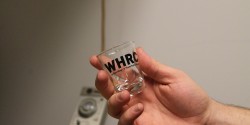My final radio station visit while in the Philadelphia-area this April was to see the station where it all began for me, WHRC at Haverford College. I was actually able to visit the station twice this spring, once while school was still in session on April 9 and then again during my college reunion in May, 2014.
 |
| LP at WHRC. Photo: J. Waits |
My relationship with WHRC goes back to 1986 when I started volunteering there in the second semester of my freshman year in college. Back then WHRC transmitted to the campus over AM carrier current. Prime time shows were during mealtime, as the station was also piped into one side of the dining center.
 |
| Vintage Record at WHRC. Photo: J. Waits |
Although I discovered WHRC in the 1980s, radio at Haverford dates back to the 1920s. The first student-built radio station, WABQ-AM, launched in 1923. After an impressive, but short life, WABQ was sold to a commercial radio group in Philadelphia in the late 1920s.
 |
| Old equipment at WHRC. Photo: J. Waits |
By the 1940s, Haverford students were setting up campus-only carrier current radio stations (WHAV, which morphed into WHRC), which existed for several decades.You can read more about the station’s history in this article that I wrote for the Haverford Magazine in 2012 and in this piece on Spinning Indie.
 |
| WHRC’s home in 2014. Photo: J. Waits |
Whenever I’ve been back on campus I’ve tried to visit WHRC. In 2009 I visited and wrote a recap for this Spinning Indie radio station field trip series. At the time, WHRC was located in the same place in the dining center basement as it was when I was a student. It was largely deserted and the radio station was in a period of change, as it was transitioning to doing podcasts and live DJ gigs.
 |
| Music from the past at WHRC. Photo: J. Waits |
In the five years since my last visit, WHRC struggled and then was recently resurrected as a streaming radio station. I’d been in contact with one of the students who got the station back up and running, so I was particularly excited to finally see the latest version of WHRC in person.
 |
| Karl Moll at WHRC. Photo: J. Waits |
The latest iteration of WHRC began in October, 2012, when its Station Manager Karl Moll (who graduated in May 2014) decided to launch the station’s stream during a campus-wide shutdown due to Hurricane Sandy. Since Fall, 2013, WHRC has been located in an old Projection Room in Haverford’s Dining Center basement. It’s right down the hall from the station’s former long-time home (which still houses some old WHRC artifacts).
 |
| Dylan Reichman at WHRC. Photo: J. Waits |
When I visited on April 9, 2014, WHRC’s Programming Director and Co-Station Manager, Dylan Reichman, was at the station training some other students on the streaming equipment. He told me that he’s happy that WHRC again has a “central space” and said that now “it feels like a radio station.” A college radio veteran already, Reichman started doing radio at Seton Hall’s college radio station WSOU-FM while he was still in high school.
 |
| WHRC schedule. Photo: J. Waits |
Although WHRC has been up and running for a few years, it’s been more of a virtual radio station, with students doing shows out of their dorm rooms up until last fall. According to the WHRC (aka Radio Fords) website, WHRC is a “web-based collective of audio content and multimedia generated by the Bi-Co [Haverford College and Bryn Mawr College] community. We aim to be a source of community news and a platform for students to express themselves through podcasts, music shows and multimedia projects.”
 |
| WHRC show archives from early 2000s on CD. Photo: J. Waits |
When I visited last semester, Reichman and Moll told me that most students do their WHRC radio shows by making a digital playlist in advance. Then can then upload their shows to the station’s interface by using a portable flash drive. The station still has a turntable, cassette decks, and CD players, but I’m not sure if they were hooked up when I visited.
 |
| Audio equipment at WHRC. Photo: J. Waits |
Even though today’s WHRC is mostly digital, there are still some analog reminders of the station’s past. Moll pointed out some old carrier current equipment to me during my visit and there is still a small collection of vinyl records from decades past.
 |
| Haverford Radio Reunion in Magill Library. May 2014. Photo: J. Waits |
I couldn’t be happier that radio is continuing at Haverford College and am every more pleased that WHRC’s illustrious history was celebrated during Alumni Weekend in May. Moll and members of Haverford’s Magill Library staff created an exhibit that was on display in the library, which served as a backdrop to a well-attended WHRC reunion. Additionally, we led a walking tour of former and current Haverford radio haunts and capped off the weekend with a panel discussion featuring radio alums from a wide range of eras.
 |
| Haverford and Bryn Mawr alums tour WHRC in May 2014. Photo: J. Waits |
I’m continuing to work on a larger history of radio at Haverford College and look forward to hearing from both alums and current students about their radio recollections.
 |
| Haverford Radio Reception. May 2014. Photo: J. Waits |
With this post, I’m finally done with my Philadelphia-area field trip reports! Be sure to take a look at the other posts and stay tuned for future write-ups from station visits in Maryland, D.C. and Illinois. You can see a complete list of all of my Spinning Indie Radio Station Field Trips here.
This post originally appeared on my blog Spinning Indie.



